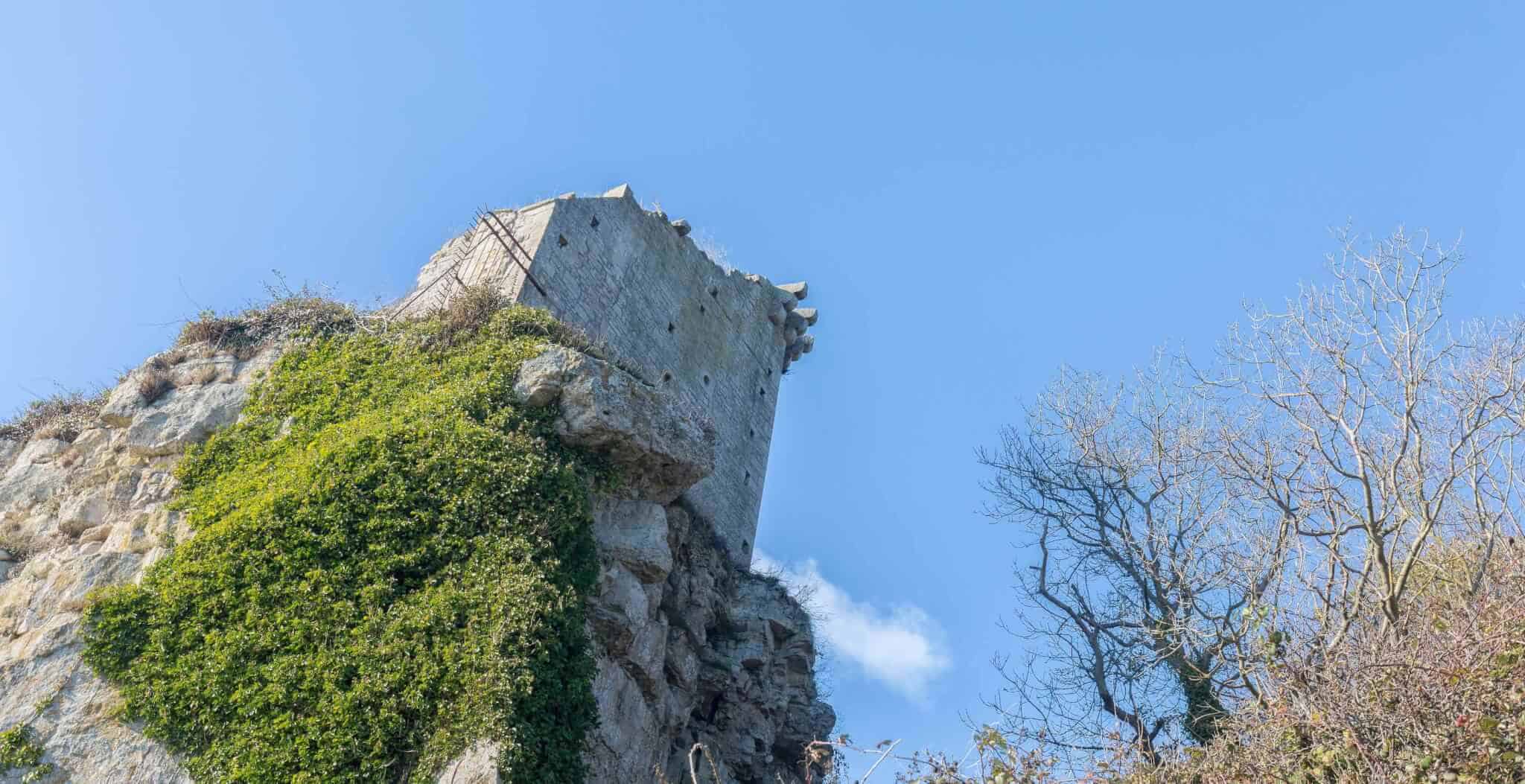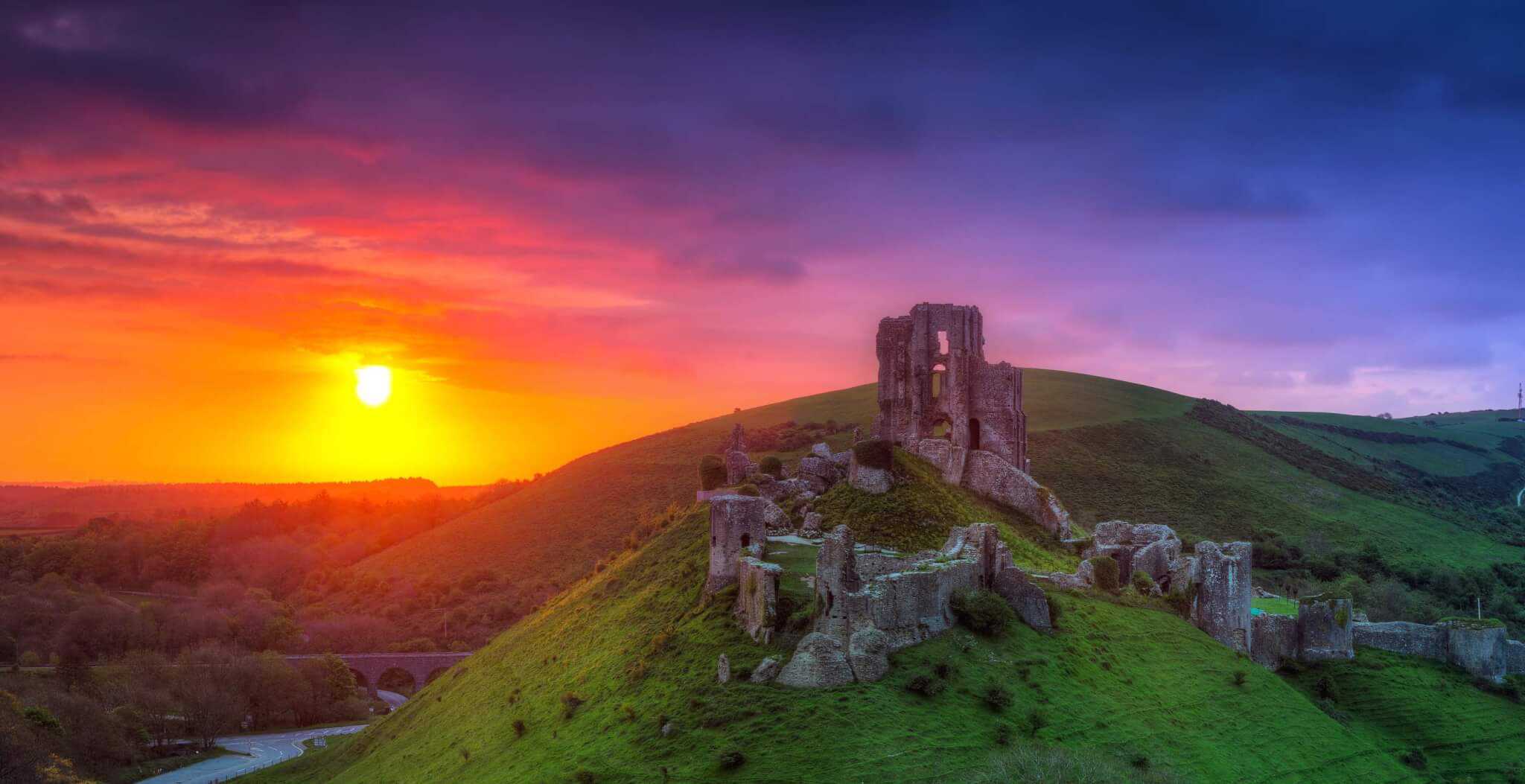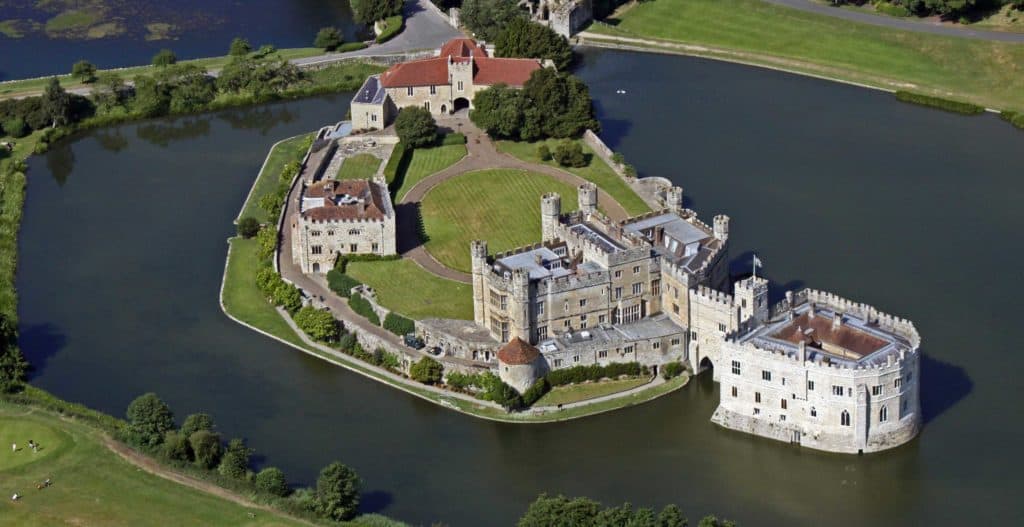Showcasing over a hundred sites on an interactive Google Map, welcome to one of the most comprehensive lists of castles in Wales. From the earthwork remains of motte and bailey fortifications to the remains of a Roman fort in Cardiff Castle, each one of the castles have been geotagged to within the nearest few metres. We have also included a short summary detailing the history of each castle, and where possible have noted opening times and entrance charges if applicable.
To get the most out of our interactive map, please select the ‘Satellite’ option below; which in our opinion, allows you to fully appreciate the castles and their defences from above.
If you do notice any omissions then please do not hesitate to contact us with the form at the bottom of the page.
Looking to stay in one of these fabulous castles? We list some of the country's finest accommodation on our castle hotels page.
Full list of Castles in Wales
| Abergavenny Castle, Abergavenny, Gwent Owned by: Monmouthshire County Council One of the earliest Norman castles in Wales, Abergavenny dates from around 1087. Originally a motte and bailey structure, the first tower built atop the motte would have been wooden. On Christmas Day in 1175, the Norman Lord of Abergavenny, William de Braose, murdered his long-standing Welsh rival Seisyll ap Dyfnwal in the great hall of the castle: the Massacre of Abergavenny. During the turbulent years of the 12th century, the castle changed hands several times between the English and Welsh. The castle was significantly added to and strengthened during the 13th and 14th centuries, whilst it was in the hands of the Hastings family. Most of the buildings were badly damaged in the English Civil War, when the castle was slighted to prevent it becoming used as a stronghold again. In 1819 the present square keep type like building, now housing the Abergavenny Museum, was constructed on top of the motte. Free and open access at any reasonable time. |
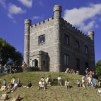 |
| Aberystwyth Castle, Aberystwyth, Ceredigion, Dyfed Owned by: Aberystwyth Town Council. Overlooking Aberystwyth harbour, the castle was built by Edward I in his endeavour to conquer Wales. Started in 1277, it was only partially completed when the Welsh rebelled, captured and burned it in 1282. Construction started again the following year under the supervision of the king's favourite architect, Master James of St George, who completed the castle in 1289. Briefly besieged in 1294, it was attacked again during the early 15th century by Owain Glyndwr, who eventually captured it in 1406. The English recaptured the castle in 1408, following a siege that involved the first known use of cannon in Britain. In 1649 during the English Civil War, Oliver Cromwell had the castle slighted to make sure that it could never be used again. Free and open access at any reasonable time. |
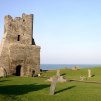 |
| Barry Castle, Barry, Glamorgan Owned by: Cadw The seat of the de Barry family, this fortified manor house was built in the 13th century to replace an earlier earthwork. Added to and strengthened in the early 14th century, the ruins of which can be seen today. Free and open access at any reasonable time. |
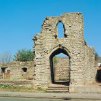 |
| Beaumaris Castle, Beaumaris, Anglesey, Gwynedd Owned by: Sir Richard Williams-Bulkeley, in the guardianship of Cadw Guarding the approach to the Menai Strait, Beaumaris, or fair marsh, was started in 1295 under the supervision of the king's favourite architect, Master James of St George. The last and largest of the castles to be built by King Edward I in his Conquest of Wales, it was at the time one of the most sophisticated examples of medieval military architecture in Britain. Work on the castle was suspended during Edward's Scottish campaigns in the early 1300’s, and as a consequence it was never fully completed. Beaumaris was briefly held by the Welsh in the Owain Glyn Dŵr (Glyndŵr, Glendower) uprising of 1404-5. Left to decay for centuries, the castle was refortified for the king during the English Civil War, but was eventually taken by Parliament in 1648, and slighted in the 1650’s to make sure that it could never be used again. Restricted opening times and entrance charges apply. |
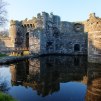 |
| Brecon Castle, Brecon, Powys Owned by: Scheduled Ancient Monument Set at the confluence of the Honddu and the River Usk, at one of the few places where the river could be forded, Bernard de Neufmarch erected the first Norman motte and bailey fortress around 1093. Llewelyn ap Iortwerth destroyed that first wooden castle in 1231, and again two years later after it was rebuilt. Eventually rebuilt in stone by Humphrey de Bohun in the early 13th century, the castle gradually fell into disrepair and now stands in the grounds of a hotel. Free and open access at any reasonable time. |
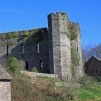 |
| Bronllys Castle, Bronllys, Powys Owned by: Cadw Late 11th, or early 12th century motte with 13th century round stone keep. Henry III briefly took control of Bronllys in 1233, and used it to conduct negotiations with Llewelyn the Great. In 1399 the castle was refortified against Owain Glyn Dŵr (Glyndŵr), but by the late 15th century it was in a state of ruin. Free and open access at any reasonable time. |
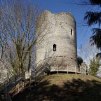 |
| Builth Castle, Builth, Powys Owned by: Scheduled Ancient Monument The first castle at Builth was a timber motte and bailey fortification built around 1100 to guard a strategic crossing of the River Wye. In the century that followed the castle was attacked, destroyed and rebuilt, occupied in turn by English and Welsh forces. In 1277, King Edward I launched his first campaign in the Conquest of Wales and refortified Builth. Using his favourite architect, Master James of St George, Edward went on to rebuild in stone a great tower on top of the earlier motte, surrounded by a substantial curtain wall with several small towers. In 1282 Llewelyn ap Gruffydd fell into an ambush after leaving the castle and was killed at nearby Cilmeri. Besieged by Madog ap LLewelyn in 1294, it was heavily damaged in an attack by Owain Glyn Dŵr a century later. Most traces of Edward’s smallest Welsh castle has long since disappeared, recycled as building material by local landowners. Free and open access at any reasonable time. |
 |
| Caer Penrhos, Penrhos, Llanrhystud, Dyfed Owned by: Scheduled Ancient Monument Well preserved ringwork fortification set within an earlier Iron Age earthwork which served as the bailey. Built around 1150, possibly by Cadwaladr, son of Gruffydd ap Cynan. Free and open access at any reasonable time. |
|
| Caerau Castle Ringwork, Caerau, Cardiff, Glamorgan Owned by: Scheduled Ancient Monument A Norman ringwork castle set within an older Iron Age hillfort. A timber palisade would have sat on top of the bank surrounding the living quarters. Free and open access at any reasonable time. |
|
| Caergwrle Castle, Caergwrle, Clwyd Owned by: Caergwrle Community Council Started in 1277, by Dafydd ap Gruffudd, possibly using Norman masons, to construct a great circular keep overlooking the surrounding countryside. The castle was still unfinished when Dafydd revolted against the rule of King Edward I in 1282. Retreating from Caergwrle, Dafydd had the castle slighted to deny its use to the invading English. Although Edward began to rebuild it, a fire gutted the castle and it was left to ruin. Free and open access at any reasonable time. |
|
| Caerleon Castle, Caerleon, Newport, Gwent Owned by: Scheduled Ancient Monument Although the Romans had fortified the site centuries before, today’s remains are mainly those of a Norman motte and bailey castle dating from around 1085. Seized by the famous William Marshal in 1217, the timber castle was rebuilt in stone. During the Welsh Revolt in 1402, forces of Owain Glyn Dŵr captured the castle, leaving it in ruins, the buildings collapsed over the centuries that followed. The castle site is now on private land, the view from the adjacent road is restricted. The tower can be seen from the Hanbury Arms pub car park. |
|
| Caernarfon Castle, Caernarfon, Gwynedd Owned by: Cadw Replacing a motte-and-bailey castle dating from the late 11th century, King Edward I of England began building his part castle, part royal palace in 1283. Intended as the administrative centre of north Wales, the defences were built on a grand scale. The work of the king's favourite architect, Master James of St George, the design is thought to be based on the Walls of Constantinople. Caernarfon was the birthplace of Edward II, the first English Prince of Wales. Sacked in 1294 when Madog ap Llywelyn led a rebellion against the English, the castle was recaptured the following year. Caernarfon’s importance declined when the Welsh Tudor dynasty ascended to the English throne in 1485. Restricted opening times and entrance charges apply. |
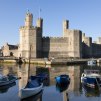 |
| Caerphilly Castle, Caerphilly, Gwent Owned by: Cadw Surrounded by a series of moats and watery islands, this medieval architectural gem was created by Gilbert ‘the Red’ de Clare, a redheaded Norman noble. Gilbert started work on the castle in 1268 following his occupation of northern Glamorgan, the Welsh prince Llywelyn ap Gruffydd signalled his objection to its building by burning the site in 1270. Unimpressed by this interruption, Gilbert persisted and completed his mammoth stronghold using the radical and unique concentric ‘walls within walls’ system of defence. A castle truly fit for a king, Gilbert added luxurious accommodation, built on a central island, surrounding by several artificial lakes. The concentric rings of walls design was adopted by Edward I, in his castles in North Wales. With the death of Llywelyn in 1282, the Welsh military threat all but disappeared and Caerphilly became the administrative centre for the considerable de Clare estate. Restricted opening times and entrance charges apply. |
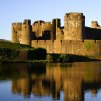 |
| Caldicot Castle, Caldicot, Newport, Gwent Owned by: Monmouthshire County Council Standing on the site of an earlier Saxon fortress, a Norman timber motte and bailey structure was erected around 1086. In 1221, Henry de Bohun, Earl of Hereford, rebuilt the four storey high keep in stone and added a curtain wall with two corner towers. When the male Bohun line died out in 1373, the castle became home to Thomas Woodstock, the youngest son of Edward II, who transformed it from a defensive fortress into a luxurious royal residence. The castle was purchased by the antiquarian JR Cobb in 1855, who restored Caldicot back to its medieval best. The castle now stands in 55 acres of Country Park, with free an open access. Restricted opening times and entrance charges apply to the castle. |
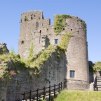 |
| Camrose Castle, Camrose, Haverfordwest, Pembrokeshire Owned by: Scheduled Ancient Monument Guarding a ford across a small river this early Norman motte and bailey fortification was built around 1080, during the first wave of Norman settlement in south Wales. William the Conqueror stayed overnight at Camrose whilst on a pilgrimage to St David’s. At a later date the castle was rebuilt with a stone perimeter wall enclosing the top of the motte, possibly with a shell keep. |
|
| Candleston Castle, Merthyr Mawr, Bridgend, Glamorgan Owned by: Scheduled Ancient Monument This fortified manor house was built in the late 14th century at the eastern edge of what is now Europe's largest sand dune system. Unfortunately, the castle builders, the Cantilupe family, after whom the castle is named, did not take into account the possibility of coastal erosion. Shortly after its completion the surrounding area began to be covered by the shifting sands, the castle only survived complete immersion thanks to its elevated position. A ruined wall now surrounds a small courtyard, around which is a hall block and tower; the south wing is a later addition. |
|
| Cardiff Castle, Cardiff, Glamorgan Owned by: City of Cardiff The original motte and bailey castle was built around 1081, shortly after the Norman Conquest of England, within the walls of a 3rd century Roman fort. From the 12th century the castle began to be rebuilt in stone, with a formidable shell keep and substantial defensive walls being added. These new defences don’t appear to have deterred the locals much, as in the years that followed the Welsh repeatedly attacked the castle and stormed it during the Owain Glyn Dŵr rebellion of 1404. Following the Wars of the Roses the military significance of the castle began to decline, and it was only in the mid-18th century when it passed into the hands of John Stuart, first Marquess of Bute, that things began to change. Employing Capability Brown and Henry Holland, he set about transforming the medieval fortress into the sumptuous stately home that remains today. Restricted opening times and entrance charges apply to the castle. |
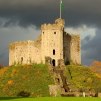 |
| Cardigan Castle, Cardigan, Dyfed Owned by: Cadwgan Preservation Trust The first motte and bailey castle was erected a mile away from the current site around 1093, by the Norman baron, Roger de Montgomery. The present castle was built by Gilbert Fitz Richard Lord of Clare, after the first was destroyed. Owain Gwynedd defeated the Normans at the Battle of Crug Mawr in 1136, and in the years that followed the castle changed hands several times as the Welsh and Normans battled for supremacy. In 1240 following the death of Llywelyn the Great, the castle fell back into Norman hands and just a few years later Earl Gilbert of Pembroke rebuilt it, adding the town walls for increased protection. It is these remains that still stand overlooking the river. Currently undergoing a major restoration project. |
|
| Carew Castle, Tenby, Pembrokeshire Owned by: Carew family Set on a strategically important site commanding a ford crossing the river, Gerald of Windsor erected the first Norman timber motte and bailey castle around 1100, building on an earlier Iron Age fort. The present stone castle dates from the 13th century, started by Sir Nicholas de Carew, the family added to and refortified over the generations. Around 1480, Sir Rhys ap Thomas a supporter of King Henry VII, set about converting the medieval castle into a home worthy of an influential Tudor gentleman. Further remodelling was started in Tudor times by of Sir John Parrot, allegedly the illegitimate son of Henry VIII. Parrot however, did not have chance to enjoy his lovely new home, arrested on a charge of treason he was confined to the Tower of London, where he died in 1592, apparently of ‘natural causes’. Restricted opening times and entrance charges apply. |
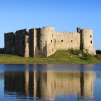 |
| Carmarthen Castle, Carmarthen, Dyfed Owned by: Scheduled Ancient Monument Although a Norman castle may have existed in Carmarthen from as early as 1094, the current castle site commanding a strategic position above the River Tywi, dates from around 1105. The original motte had massive stone defences added in the 13th century by the famous William Marshal, Earl of Pembroke. Sacked by Owain Glyn Dŵr (Glyndŵr) in 1405, the castle later passed to Edmund Tewdwr, father of the future Henry VII. Converted into a prison in 1789, it now stands next to the council offices, somewhat lost amidst the modern urban buildings. |
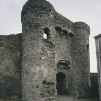 |
| Carndochan Castle, Llanuwchllyn, Gwynedd Owned by: Scheduled Ancient Monument Built high on a rocky crag by one of the three major princes of Wales who ruled in the 13th century, either Llywelyn Fawr, Dafydd ap Llywelyn, or Llywelyn the Last, the castle is constructed in typical Welsh style. The defensive outer towers and central keep guarded the southern borders of the kingdom of Gwynedd. It is not recorded when Carndochan was finally abandoned, there is however some limited archaeological evidence to suggest that the castle was either sacked or slighted, which could help explain its poor state of preservation. Free and open access at any reasonable time. |
|
| Carreg Cennen Castle, Trapp, Llandeilo, Dyfed Owned by: Cadw Using the natural environment to great effect, the first stone castle on the site was erected by Lord Rhys, Rhys of Deheubarth, in the late 12th century. Captured by King Edward I of England in his first Welsh campaign of 1277, the castle came under almost constant Welsh attack, first by Llewelyn ap Gruffudd, and then by Rhys ap Maredudd. As a reward for his support, Edward granted the castle to John Giffard of Brimpsfield who between 1283 and 1321, rebuilt and strengthened the fortresses defences. The castle changed between Welsh and English occupation several times during the troubled medieval period. A Lancastrian stronghold during the War of the Roses, in 1462 Carreg Cennen was slighted by 500 Yorkist troops to prevent it being fortified again. Restricted opening times and entrance charges apply. |
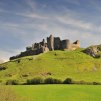 |
| Carreghoffa Castle, Llanyblodwel, Powys Owned by: Cadw Built around 1101 by Robert de Bellesme, this border fortification was to change hands several times between the English and Welsh over its relatively short life span. Just a year after it was built it was seized by the army of King Henry I. Around 1160 Henry II repaired and refortified the castle, only to lose control of it to the Welsh forces of Owain Cyfeiliog and Owain Fychan in 1163. The subject of many more border battles and skirmishes, it is thought that the castle met its end in the 1230’s when it was destroyed by Llywelyn ab Iorwerth. Free and open access at any reasonable time. |
|
| Castell Aberlleiniog, Beaumaris, Anglesey, Gwynedd Owned by: Menter Môn Built around 1090 for Hugh d'Avranche, the powerful 1st Earl of Chester, the Norman castle apparently survived a siege in 1094 by the Welsh forces of Gruffydd ap Cynan. The only motte and bailey type fortification on Anglesey, the stone structures still visible on the castle mound are part of the English Civil War defences dating from the mid-17th century and not the original Norman buildings. The site is currently being restored, normally with free and open access at any reasonable time. |
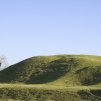 |
| Castell Blaen Llynfi, Bwlch, Powys Owned by: Scheduled Ancient Monument Built around 1210 by the Fitz Herbert family, the castle was sacked by Prince Llywelyn ab Iorwerth in 1233. Rebuilt shortly afterwards, like many other border castles it changed hands between the Welsh and English several times before being declared ruinous in 1337. The remains of the large bailey, ditch and curtain wall are in a poor state of conservation. Free and open access at any reasonable time. |
|
| Castell Carn Fadryn, Llŷn Peninsula, Gwynedd Owned by: Scheduled Ancient Monument Showing evidence of three phases of defensive structures, the first an Iron Age hillfort dating from the around 300BC that was extended and reinforced in 100BC. The third phase is one of the earliest medieval Welsh stone castles constructed, thought to have been ‘newly built’ by the sons of Owain Gwynedd in 1188. Unusual for that time, not built to keep the English out, but to impose individual authority in a power struggle between each of Gwynedd’s sons. The rudimentary stone buildings and drystone wall enclosure are set within the remains of the extensive ancient hillfort. Free and open access at any reasonable time. |
|
| Castell Coch, Tongwynlais, Cardiff, Glamorgan Owned by: Cadw This Victorian fantasy (or folly) castle was built with the untold wealth of the Marquess of Bute and eccentric architectural genius of William Burges, owner and architect of Cardiff Castle. Built on the foundations of an original medieval fortress, Burges began work on Castle Coch in 1875. Although he died 6 years later, the work was completed by his craftsmen, and together they created the ultimate Victorian fantasy of what a medieval castle should look like, with just a twist of High Gothic. Never intended as a permanent residence the castle's use was limited, the Marquess never came after its completion and the family’s visits were infrequent. Restricted opening times and entrance charges apply. |
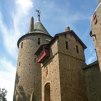 |
| Castell Crug Eryr, Llanfihangel-nant-Melan, Powys Owned by: Scheduled Ancient Monument Crug Eryr, or Eagle’s Crag, was a relatively crude earth and timber motte and bailey type fortification. The origins of the castle are unclear, although it thought to have been constructed by the princes of Maelienydd, around 1150. Captured by the Normans in the late 12th century, the castle was retaken by the Welsh and remained in use into the 14th century. A later well-known bard, known as Llywelyn Crug Eryr, is thought to have lived at the castle at one time. On private property, the castle can be viewed from the nearby A44 road. |
 |
| Castell Cynfael, Tywyn, Gwynedd Owned by: Scheduled Ancient Monument A traditional motte and bailey fortification, built not by the Normans however, but by the Welsh prince Cadwaladr ap Gruffudd in 1147. Cadwaladr was the son of Gruffudd ap Cynan, who after escaping imprisonment around 1094, had driven the Normans out of Gwynedd, with a little help from his Irish friends and relations. Built in true ‘Norman style’, the castle commanded a good view of the Dysynni river crossing, at the head of the strategically important junction of the Dysynni and Fathew valleys. In 1152 following a family feud, Cadwaladr was forced into exile and his brother Owain assumed control. Cynfael probably fell out of use after Llewelyn the Great built Castell y Bere in 1221. Free and open access at any reasonable time. |
|
| Castell Dinas Bran, Llangollen, Clwyd Owned by: Scheduled Ancient Monument The remains of 13th century castle stand on the site of an Iron Age hill fort. Probably built by Gruffudd II ap Madog, ruler of north Powys, in 1277 the castle was set to be besieged by Henry de Lacy, Earl of Lincoln, when the Welsh defenders burned it to prevent the English using it. Sometime before 1282 the castle was again occupied by Welsh forces, but appears to have suffered badly in war that resulted in the death of Llewelyn Prince of Wales. The castle was never rebuilt and lapsed into ruin. Free and open access at any reasonable time. |
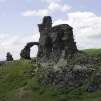 |
| Castell Dinerth, Aberarth, Dyfed Owned by: Scheduled Ancient Monument Built by the de Clare family around 1110, this Norman motte and bailey castle had a short and violent history. Dinerth changed hands at least six times and was destroyed and rebuilt on two occasions, before finally meeting its end in 1102. Now overgrown, the castle mounds and the defensive ditches are still visible. Free and open access at any reasonable time. |
|
| Castell Du, Sennybridge, Dyfed Owned by: Scheduled Ancient Monument Also known as Sennybridge Castle and Castell Rhyd-y-Briw, this native Welsh castle built around 1260 is believed to be the work of Llywelyn ap Gruffudd, Prince of Wales. Its history is vague, although it seems likely that it was captured by Edward I of England during the war of 1276-7 and was subsequently abandoned. The remains of a D-shaped tower favoured by Welsh military architects are still visible, but much of the site remains unexcavated. Located on private land. |
|
| Castell Gwallter, Llandre, Dyfed Owned by: Scheduled Ancient Monument This typical earth and timber motte and bailey castle was built sometime before 1136, by the distinguished Norman knight Walter de Bec, d'Espec. Like many similar castles it appears to have been destroyed shortly after this, possible by Welsh attacks. The last mention of it in any historical record dates from 1153. This site is now completely overgrown with only the earthworks are in evidence. On private property but can be viewed from the nearby right of way. |
|
| Castell Machen, Machen, Glamorgan Owned by: Scheduled Ancient Monument Also known as Castell Meredydd, this traditional Welsh stone castle is thought to have been built by Maeredydd Gethin, prince of Gwynllwg, around 1201. Used by Morgan ap Hywell after he was ousted from his main powerbase of Caerleon by the Normans, in 1236 Gilbert Marshal, Earl of Pembroke, captured the castle and added to its defences. Although it passed briefly to the powerful de Clare family, it is thought that the castle went out of use shortly after this. Set on a ledge on a south-facing hillside, only fragments of the keep and curtain walls remain. |
|
| Castell y Blaidd, Llanbadarn Fynydd, Powy Owned by: Scheduled Ancient Monument Also known as Wolf's Castle, this D-shaped Norman ringwork defensive enclosure may never have been completed. Free and open access at any reasonable time. |
|
| Castell-y-Bere, Llanfihangel-y-pennant, Abergynolwyn, Gwynedd Owned by: Cadw Started by Prince Llywelyn ab Iorwerth ('the Great') around 1221, this great stone castle was built to defend the south-west princedom of Gwynedd. In the 1282 war with King Edward I, Llywelyn's grandson, Llywelyn the Last, was killed and Castell y Bere was taken by English forces. Edward I expanded the castle and established a small town beside it. In 1294 the Welsh leader Madoc ap Llywelyn mounted a major revolt against English rule, and the castle was besieged and burnt. Castell y Bere fell into disrepair and ruin after this. Free and open access within restricted opening times. |
 |
| Castle Caereinion Castle, Castle Caereinion, Powys Owned by: Scheduled Ancient Monument The first earth and timber motte and bailey castle was built by Madog ap Maredudd, prince of Powys, around 1156. After Madog's nephew, Owain Cyfeiliog, had sworn allegiance to the English, the castle was seized by Lord Rhys and Owain Gwynedd in 1166. A little later, and with the help of his Norman allies, Owain attacked the castle destroying its fortifications, after which it apparently fell into ruin. Only the raised mound, or motte, is visible in a corner of the churchyard. |
|
| Cefnllys Castle, Llandrindod Wells, Powys Owned by: Scheduled Ancient Monument Two castles built one after the other at opposite ends of a high narrow ridge. The more imposing northern fortress was erected by the English lord Roger Mortimer around 1242, during his battles with Llywelyn ap Gruffudd, Prince of Wales. After suffering the wrath of Llywelyn the first castle was badly damaged in 1262, and as a result the second castle was started in 1267. This second castle was sacked by Cynan ap Maredudd during the revolt of Madog ap Llywelyn in 1294-5. Recorded as being in ruins by the late 16th century, little remains of Mortimer's first fortress. Free and open access at any reasonable time. |
|
| Chepstow Castle, Chepstow, Gwent Owned by: Cadw Set atop cliffs controlling the main crossing of the River Wye is the oldest stone fortification of its type in Britain. Started by the Norman Lord William fitzOsbern in 1067, it was one of a chain of castles built to secure the troubled border region between England and Wales. Most early Norman castles erected after the Conquest of England were simple earth and timber motte and bailey structures, Chepstow however was different; it was built in stone from the very start, using re-cycled materials from nearby Caerwent Roman town to create a stone tower enclosed by wooden baileys. In 1189 Chepstow passed to the famous William Marshal, perhaps the greatest knight of the medieval period, who greatly extended and strengthened the fortress into what we see today. In the mid-17th century, during the English Civil War the castle twice changed hands between the king and Parliament. Used as a prison following the Restoration of the Monarchy, the castle eventually fell to ruin. Restricted opening times and entrance charges apply. |
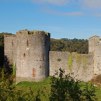 |
| Chirk Castle, Wrexham, Clwyd Owned by: National Trust Built between 1295 and 1310 by Roger Mortimer de Chirk as part of King Edward I's chain of fortresses across the north of Wales, it guards the entrance to the Ceiriog Valley. The castle was extensively remodelled in the late 16th century by Sir Thomas Myddelton, who transformed Chirk from a military fortress into a comfortable country mansion. Seized by the crown during the English Civil War, the castle sustained serious damage and required major reconstruction work. Chirk’s interior was totally reworked in the Gothic style by the famous architect A.W. Pugin, in 1845. Restricted opening times and entrance charges apply. |
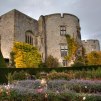 |
| Cilgerran Castle, Cardigan, Pembrokeshire, Dyfed Owned by: Cadw Set on a rocky outcrop overlooking the River Teifi, the first earth and timber motte and bailey fortification was built around 1100, shortly after the Norman Invasion of England. The likely scene of a romantic abduction, when at Christmas 1109, Owain ap Cadwgan, prince of Powys, attacked the castle and stole away with Nest the wife of Gerald of Windsor. Some years later Gerald caught up with Owain and killed him in an ambush. Cilgerran was taken by Llywelyn the Great in 1215, but was recaptured in 1223 by William Marshal the younger, Earl of Pembroke, who rebuilt the castle in its present form. Restricted opening times and entrance charges apply. |
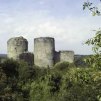 |
| Coity Castle, Bridgend, Glamorgan Owned by: Cadw Although originally established soon after 1100 by Sir Payn "the Demon" de Turberville, one of the legendary Twelve Knights of Glamorgan, much of the present day castle dates from the 14th century and later. Rebuilt following a siege by Owain Glyn Dŵr in 1404-05, a new west gate in the outer ward and a new gatehouse in the south tower were also added. The castle appears to have fallen out of use and into ruin after the 16th century. Free and open access within restricted opening times. |
 |
| Conwy Castle, Conwy, Gwynedd Owned by: Cadw Built for the English King Edward I, by his favourite architect, Master James of St George, the castle is one of the finest surviving medieval fortifications in Britain. Perhaps the most magnificent of his Welsh fortresses, Conwy is one of Edward’s "iron ring" of castles, built to subdue the rebellious princes of north Wales. Offering extensive views across mountains and sea from the grandeur of its eight massive towers, two barbicans (fortified gateways) and surrounding curtain walls, Edward spent a staggering £15,000 building the fortress. The largest sum spent on any of his Welsh castles, Edward even had the town’s defensive walls constructed in order to protect his English builders and settlers from the local hostile Welsh population. Restricted opening times and entrance charges apply. |
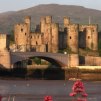 |
| Criccieth Castle, Criccieth, Gwynedd Owned by: Cadw Originally built by Llywelyn the Great in the early 13th century, Criccieth stands high above Tremadog Bay. Several years later Llywelyn's grandson, Llywelyn the Last, added a curtain wall and a large rectangular tower. The castle fell in a siege to the English King Edward I in 1283, who further modified and improved its defences. This now mighty fortress withstood a Welsh siege led by Madog ap Llewelyn in 1295, however Owain Glyn Dŵr sealed Criccieth’s fate when he captured and burnt the castle in 1404. This was to be the last major Welsh rebellion against English rule and the castle remained in a ruined state until 1933, when it was passed to the government by Lord Harlech. Restricted opening times and entrance charges apply. |
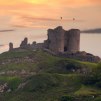 |
| Crickhowell Castle, Crickhowell, Powys Owned by: Scheduled Ancient Monument Originally built as a simple earth and timber motte and bailey fortification by the De Turberville family in the 12th century, the site provides commanding views along the Usk valley. The castle was remodelled in stone in 1272 by Sir Grimbald Pauncefote, who had married Sybil, a Turberville heiress. Refortified by the royal command of Henry IV, Owain Glyn Dŵr sealed Crickhowell’s fate when his forces sacked the castle in 1404, leaving it in ruins. Also known as Ailsby's Castle, there is free and open access at any reasonable time. |
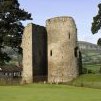 |
| Cwn Camlais Castle, Sennybridge, Powys Scheduled Ancient Monument With views across to the Brecon Beacons, this Norman motte and bailey castle dates from the 12th century. Thought to have been destroyed around 1265, it was never rebuilt and the scant remains include the rubble footprint of a round tower atop the rocky mound. Free and open access at any reasonable time. |
|
| Deganwy Castle, Deganwy, Gwynedd Owned by: Scheduled Ancient Monument Set at the mouth of the River Conwy, the scant remains of a Dark Age fortress now amount to little more than ditches and mounds atop a massive rocky outcrop. Headquarters of Maelgwn Gwynedd, King of Gwynedd (520–547), it is likely that Deganwy was first occupied during Roman times. The castle was rebuilt in stone by the English King Henry III, but was abandoned and finally destroyed by Llywelyn ap Gruffudd, Prince of Wales in 1263. Edward I later built Conwy Castle just across the estuary; it is said using recycled materials from Deganwy. Today’s stone remnants and footprint date mainly from Henry III's fortification and can be found within the suburbs of modern Llandudno. Free and open access at any reasonable time. |
 |
| Denbigh Castle, Denbigh, Clwyd Owned by: Cadw The current fortress was constructed by Edward I following his 13th century conquest of Wales. It was built on the site of a former Welsh stronghold held by Dafydd ap Gruffydd, the brother of Llywelyn the Last. Standing on a rocky promontory overlooking the Welsh town of Denbigh, the bastide, or planned settlement, was built at the same time as the castle, an attempt by Edward to pacify the Welsh. Started in 1282, Denbigh was attacked and captured during the revolt of Madog ap Llywelyn, work on the incomplete town and castle was halted until it was recaptured a year later by Henry de Lacy. In 1400, the castle resisted a siege by the forces of Owain Glyn Dŵr, and during the Wars of the Roses in the 1460’s, the Lancastrians under the command of Jasper Tudor, failed on two occasions to take Denbigh. The castle endured a six-month siege during the English Civil War before finally falling to Parliamentarian forces; it was slighted to prevent further use. Restricted opening times and entrance charges apply. |
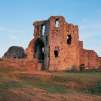 |
| Dinefwr Castle, Llandeilo, Dyfed Owned by: National Trust The first castle on the site was built by Rhodri the Great of Deheubarth, the present stone structure however dates from the 13th century and the times Llywelyn the Great of Gwynedd. At that time Llywelyn was extending the boundaries of his princedom The English King Edward I captured Dinefwr in 1277, and in 1403 the castle survived a siege by the forces of Owain Glyn Dŵr. Following the Battle of Bosworth in 1483, Henry VII gifted Dinefwr to one of his most trusted generals, Sir Rhys ap Thomas, who carried out extensive modifications and rebuilding of the castle. It was one of Thomas's descendants who built the nearby mock Gothic mansion of Newton House, the castle keep being modified to be used as a summer house. Free and open access at any reasonable time. |
 |
| Dolbadarn Castle, Llanberis, Gwynedd Owned by: Cadw One of three castles built by the Welsh prince Llywelyn the Great during the early 13th century to defend the major military routes through Snowdonia. Traditionally the Welsh princes had not constructed castles, using undefended palaces called llysoedd, or courts instead, Dolbadarn however features a large stone round tower, described as being "the finest surviving example…” Dolbadarn was captured by the English King Edward I in 1284, who recycled much of its materials to build his new castle at Caernarfon. Used as a manor house for some years, the castle eventually fell into disrepair during the 18th century. Free and open access during restricted dates and times. |
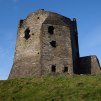 |
| Dolforwyn Castle, Abermule, Powys Owned by: Cadw Started in 1273 by Llywelyn ap Gruffudd ‘the Last’, this Welsh stone fortress is sited on a high ridge with a planned new town alongside it. One of the first castles to fall in the English King Edward I’s Conquest of Wales, Dolforwyn was besieged and burnt in 1277, along with the settlement. The settlement was moved down the valley a little and appropriately renamed Newtown! By the late 14th century the castle had fallen into disrepair. Free and open access during restricted dates and times. |
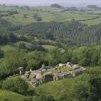 |
| Dolwyddelan Castle, Dolwyddelan, Gwynedd Owned by: Cadw Built between 1210 and 1240 by Llywelyn the Great, Prince of Gwynedd, the castle guarded a main route through north Wales. In January 1283, Dolwyddelan was captured by the English King Edward I during the final stages of his Conquest of Wales. Restricted opening times and entrance charges apply. |
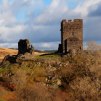 |
| Dryslwyn Castle, Llandeilo, Dyfed Owned by: Cadw Built around 1220 by the princes of Deheubarth, Dryslwyn was captured by the forces of English King Edward I in 1287. Captured by the forces of Owain Glyn Dŵr in the summer of 1403, the castle appears to have been demolished in the early 15th century, perhaps to stop Welsh rebels using it again. Free and open access during restricted dates and times. |
 |
| Dryslwyn Castle, Llandeilo, Dyfed Owned by: Cadw Built around 1220 by the princes of Deheubarth, Dryslwyn was captured by the forces of English King Edward I in 1287. Captured by the forces of Owain Glyn Dŵr in the summer of 1403, the castle appears to have been demolished in the early 15th century, perhaps to stop Welsh rebels using it again. Free and open access during restricted dates and times. |
|
| Ewloe Castle, Hawarden, Clwyd Owned by: Cadw With its D-shaped tower, this typical Welsh castle was probably built by Llywelyn ap Gruffudd 'the Last' sometime after 1257. Built from local stone, the construction work may not have not been completed before the castle was captured by the English King Edward I in 1277, during his Conquest of Wales. Free and open access during restricted dates and times. |
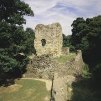 |
| Flint Castle, Flint, Clwyd Owned by: Cadw Built by the English King Edward I in his campaign to conquer Wales, Flint was the first of Edward's ‘Iron Ring’, a chain of fortresses encircling north Wales to subjugate the unruly Welsh princes. Its construction began in 1277, on a site chosen for its strategic position, just one day's march from Chester and close to a ford back to England. During the Welsh Wars the castle was besieged by the forces of Dafydd ap Gruffydd, brother of Llywelyn the Last, and later in 1294 Flint was attacked again during the revolt of Madog ap Llywelyn. During the English Civil War, Flint was held by the Royalists, but was captured by the Parliamentarians in 1647 following a three-month siege; the castle was slighted to prevent its reuse. Free and open access at any reasonable time. |
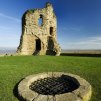 |
| Grosmont Castle, Grosmont, Gwent Owned by: Cadw The first earth and timber motte and bailey fortification was rebuilt in local red sandstone during the 13th century and enclosed by a high curtain wall with three stone towers. In 1267 King Henry III granted the castle to his second son, Edmund Crouchback, who set about converting the fortress into a royal residence. Attacked in March 1405 by a Welsh army led by Rhys Gethin, the siege was eventually relieved by forces led by Prince Henry, the future English King Henry V. Grosmont appears to have fallen into disuse after this, as by the early 16th century records indicate that it was abandoned. Free and open access during restricted dates and times. |
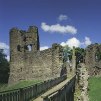 |
| Harlech Castle, Harlech, Gwynedd Owned by: Cadw Translated as 'high rock', Harlech stands atop a rocky outcrop overlooking Cardigan Bay. Built between 1282 and 1289 by the English King Edward I during his invasion of Wales, the work was overseen by the king’s favourite architect, James of St George. The castle played an important role in several of the Welsh Wars, withstanding the siege of Madog ap Llywelyn between 1294–95, but falling to Owain Glyn Dŵr in 1404. During the Wars of the Roses, the castle was held by the Lancastrians for seven years, before Yorkist troops forced its surrender in 1468. The longest siege in British history is immortalised in the song Men of Harlech. Held for the king during the English Civil War, Harlech was the last castle to fall to Parliamentary forces in March 1647. Restricted opening times and entrance charges apply. |
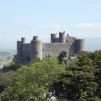 |
| Haverfordwest Castle, Pembrokeshire, Dyfed Owned by: Pembrokeshire National Park Authority The original earth and timber motte and bailey fortification was rebuilt in stone sometime before 1220, when it withstood an attack by Llewelyn the Great, who had already burned the town. In 1289, Queen Eleanor the wife of Edward I acquired the castle and began rebuilding it as a royal residence. The castle survived an attack in 1405, during Owain Glyn Dŵr’s War of Independence. During the English Civil War the castle changed hands four times between the Royalists and Parliamentarians; Cromwell finally ordered the castle destroyed in 1648. Restricted opening times and entrance charges apply. |
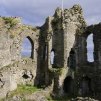 |
| Hawarden Old Castle, Hawarden, Clwyd Owned by: Scheduled Ancient Monument Replacing an earlier earth and timber motte and bailey Norman fortification, the current castle was rebuilt in stone during the 13th century. During the Welsh struggle for independence, in 1282 Dafydd ap Gruffudd captured Hawarden in a coordinated attack on English castles in the area. Angered by such a challenge to his authority the English King Edward I, ordered Dafydd to be hanged, drawn, and quartered. The castle was later seized during the revolt of Madog ap Llywelyn in 1294. After the English Civil War in the 17th century the castle was slighted in order to prevent its reuse. The old castle ruins now lie on the New Hawarden Castle estate, the grand former home of British Prime Minister, W.E. Gladstone. Located on private land, occasionally open to the public on summertime Sundays. |
|
| Hay Castle, Hay-on-Wye, Powys Owned by: Hay Castle Trust One of the great medieval fortifications built to control the troubled border region of England and Wales. Constructed in the late 12th century by the powerful Norman Lord William de Braose, the castle was sacked by Llewelyn the Great, in 1231, and rebuilt by Henry III who also added the town walls. Captured by Prince Edward (later Edward I) in 1264 and then by Simon de Montfort's forces in 1265, the castle resisted the advances of Owain Glyn Dŵr’s rising of 1405. The castle served as residence for the Dukes of Buckingham, until the last duke was executed by Henry VIII in 1521. After this the castle gradually fell into the ruin we see today. Free and open access at any reasonable time. |
|
| Kenfig Castle, Mawdlam, Glamorgan Owned by: Scheduled Ancient Monument Built shortly after the Norman Conquest of England, the first earth and timber motte and bailey fortification was rebuilt in stone during the 12th century. Between 1167 and 1295 Kenfig was sacked by the Welsh on at least six separate occasions. By the late 15th century the castle and town that had grown within its outer ward had been abandoned, as a consequence of encroaching sand dunes. Free and open access at any reasonable time. |
|
| Kidwelly Castle, Kidwelly, Glamorgan Owned by: Cadw The early Norman earth and timber fortification was gradually rebuilt in stone from 1200 onwards, adopting the latest half-moon shaped castle design. Further defences were added and improved over the following 200 years by the earls of Lancaster. Kidwelly was unsuccessfully besieged by the Welsh forces of Owain Glyn Dŵr in 1403, who had already taken the town. Relieved after just three weeks, the castle and town were rebuilt on the instructions of the English King Henry V. Perhaps familiar to some, Kidwelly appears as a location for the film Monty Python and the Holy Grail. Restricted opening times and entrance charges apply. |
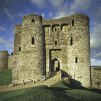 |
| Laugharne Castle, Kidwelly, Laugharne, Dyfed Owned by: Cadw Standing high on a clifftop setting overlooking the River Taf, the first small Norman earthwork fortification was rebuilt in stone during the late 12th century. The castle was captured by Llywelyn the Great in his campaign across southern Wales in 1215. And again in 1257, it suffered in another Welsh uprising when the powerful Norman noble Guy De Brian was captured at Laugharne by Llywelyn ap Gruffudd and the castle destroyed. The de Brian family refortified Laugharne, adding the strong stone walls and towers we see today to counter the threat of the Owain Glyndwr rising in 1405. Following a weeklong siege during the 17th century English Civil War the castle was badly damaged, it was later slighted to prevent any further use and left as a romantic ruin. Restricted opening times and entrance charges apply. |
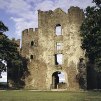 |
| Llanblethian Castle, Cowbridge, Glamorgan Owned by: Cadw Also known as St Quintins Castle, named after Herbert de St Quentin, who is thought to have built the first timber and earth fortification on the site around 1102. In 1245, the castle and lands were acquired by the de Clare family, who started to build the stone structure which stands today. Gilbert de Clare met his end at the Battle of Bannockburn in 1314 and it is thought likely that the castle was never fully completed. Free and open access during restricted dates and times. |
|
| Llandovery Castle, Llandovery, Dyfed Owned by: Scheduled Ancient Monument The first Norman earth and timber motte and bailey fortification was started around 1116 and was almost immediately attacked and partially destroyed by Welsh forces under Gruffydd ap Rhys. The castle changed hands several times over the next century or so, finally falling to the English King Edward I in 1277 who refortified the defences. Briefly captured by the Welsh forces of Llywelyn the Last in 1282, it was again attacked during the Owain Glyn Dŵr rebellion in 1403 and left a partial ruin. Free and open access at any reasonable time. |
 |
| Llanilid Castle, Llanilid, Glamorgan Owned by: Scheduled Ancient Monument This well-preserved raised ringwork, or low circular mound, once protected a timber Norman fortification. Probably built by the St Quintin family, lords of the manor until 1245, the wooden palisades of the castle sat atop the summit of the mound protected by a surrounding ditch. There is no evidence to suggest that stone walls ever replaced the wooden structure. Free and open access at any reasonable time. |
|
| Llansteffan Castle, Llansteffan, Dyfed Owned by: Cadw Sited on a headland overlooking the mouth of the Tywi, the castle controlled an important river crossing. The first Norman earth and timber enclosure, or ringwork, was set within the ancient defences of an Iron Age fort. Rebuilt in stone from the late 12th century onwards by the Camville family, the castle was briefly held on two occasions by the forces of Owain Glyn Dŵr in 1403 and 1405. Free and open access during restricted dates and times. |
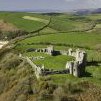 |
| Llantrisant Castle, Llantrisant, Glamorgan Owned by: Scheduled Ancient Monument Controlling a strategically important route into the valleys below, the original Norman fortification was rebuilt in stone around 1250 by Richard de Clare, lord of Glamorgan. Damaged during a Welsh uprising led by Madog ap Llywelyn in 1294, and again in 1316 by Llywelyn Bren, it is thought that the castle eventually met its end in 1404 during the Owain Glyn Dŵr rebellion. The remains of the castle tower now stand in parkland in the centre of town. |
|
| Llawhaden Castle, Llawhaden, Pembrokeshire Owned by: Cadw The fortified palace of the bishops of St Davids, was started in 1115 by Bishop Bernard. This first earth and timber ringwork defence was totally rebuilt between 1362 and 1389 by Bishop Adam de Houghton. The much grander bishop’s palace that evolved included two suites of residences, an impressive twin-towered gatehouse, great hall and chapel. The palace had fallen from favour during the 15th century, and was in state of disrepair by the late 16th century. Free and open access at any reasonable time. |
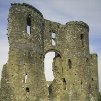 |
| Loughor Castle, Loughor, Glamorgan Owned by: Cadw Controlling a strategic crossing of the Gower Peninsula, the original Norman ringwork defences topped by a wooden palisade, were set within the former Roman fort of Leucarum. In the two centuries that followed, the castle was attacked in the Welsh uprising of 1151, and later captured by the forces of Llywelyn the Great in 1215. The Norman noble John de Braose acquired the castle in 1220 and set about repairing and strengthening its stone defences. Loughor fell out of use following King Edward I’s Conquest of Wales, and gradually fell into ruin. Free and open access during restricted dates and times. |
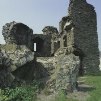 |
| Mold Castle, Mold, Clwyd Owned by: Scheduled Ancient Monument This early Norman earthen motte and bailey fortification was founded by Robert de Montalt around the 1140. Captured by Owain Gwynedd in 1147, the castle changed hands several times in the troubled century that followed along the England and Wales border. Free and open access at any reasonable time. |
|
| Monmouth Castle, Monmouth, Gwent Owned by: Cadw Built in the late 11th century by William fitz Osbern, the castle was strengthened and added to in the centuries that followed. A favourite residence of Henry IV, in 1387 the castle witnessed the birth of the future King Henry V. During the English Civil War, Monmouth changed hands three times, finally falling to the Parliamentarians in 1645. The castle was subsequently slighted to prevent its reuse and a residence known as Great Castle House was built on the site in 1673, which is now home to the Royal Monmouthshire Royal Engineers museum. Free and open access during restricted dates and times. |
|
| Montgomery Castle, Montgomery, Powys Owned by: Cadw Built by Henry III in 1223 to guard the Welsh border region, the castle and surrounding walled town took a mere 11 years to complete. Montgomery had a relatively short military life, as after the final Welsh War in the late 13th century the castle’s status as a front line fortress was reduced. Attacked by the Welsh forces of Owain Glyn Dŵr in 1402, the town was and sacked and burned, however the castle fortress withstood the assault. In 1643 the castle was surrendered to Parliamentary forces in the English Civil War, it was later slighted to prevent it being used again for military purposes. Free and open access during restricted dates and times. |
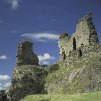 |
| Morlais Castle, Merthyr Tydfil, Glamorgan Owned by: Scheduled Ancient Monument Built on the site of an Iron Age hillfort high in the Glamorgan uplands, the castle was started around 1287 by Gilbert de Clare, earl of Gloucester on land claimed by Humphrey de Bohun, earl of Hereford. This land grab disagreement apparently turned violent and in 1290 King Edward I was forced to intervene in person, marching his forces into the area to settle the dispute between the warring earls. In 1294 Morlais was captured by the last native Welsh Prince, Madog ap Llywelyn. After the final Welsh War in the late 13th century and due to its remote location, the castle was abandoned and left to ruin. Free and open access at any reasonable time. |
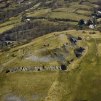 |
| Narbeth Castle, South Wales Owned by: Scheduled Ancient Monument The first Norman fortress on the site dates from 1116, although the current stone structure was erected by Andrew Perrot in the 13th century. A much earlier castle may have occupied the site however, as ‘Castell Arbeth’ is mentioned in the Mabinogion, a collection of ancient myths and legends …as the home of Pwyll, Prince of Dyfed. Narbeth was successfully defended during the Glyndwr rebellion between 1400 and 1415, but was ‘slighted’ after being taken by Oliver Cromwell in the English Civil War. Free and open access at any reasonable time. |
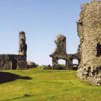 |
| Neath Castle, Neath, Glamorgan Owned by: Scheduled Ancient Monument Built to guard a crossing of the River Nedd, the Normans erected their first earth and timber ringwork fortification alongside a former Roman site in 1130. Subject to almost continuous raids by the Welsh, the castle was rebuilt in stone sometime in the early 13th century, possibly after being destroyed by Llywelyn ap Iorwerth in 1231. In the early 14th century the castle was again sacked, this time by the enemies of the then owner, the extremely unpopular lord of Glamorgan, Hugh le Despenser, favourite of Edward II. It was the rebuilding work following this latest altercation that produced the grand gatehouse that we see today. |
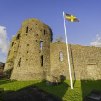 |
| Nevern Castle, Pembrokeshire, Dyfed Owned by: Scheduled Ancient Monument Also known as Castell Nanhyfer, the first Norman earth and timber motte and bailey fortification was erected within a much earlier Iron Age site around 1108. Built by Robert fitz Martin, lord of Cemmaes, the castle was captured and Robert expelled during the Welsh rebellion of 1136. The fitz Martin’s regained Nevern when William fitz Martin married Angharad, the daughter of the Welsh Lord Rhys ap Gruffudd. Lord Rhys appears to have had a rethink, when in 1191 he stormed the castle and turned it over to his son, Maelgwyn. After the final Welsh War in the late 13th century, the castle was abandoned and left to ruin. Free and open access at any reasonable time. |
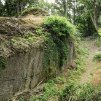 |
| Newcastle Castle, Bridgend, Glamorgan Owned by: Scheduled Ancient Monument Originally built as a Norman ringwork fortification in 1106, by William de Londres, one of the legendary Twelve Knights of Glamorgan. These early timber defences were strengthened and rebuilt in stone around 1183, in response to a Welsh uprising led by the Lord of Afon, Morgan ap Caradog. Owned by the Turberville family for many years, who had little use for it as their main seat was at nearby Coity Castle, it seems to have fallen out of use after this. Free and open access at any reasonable time. |
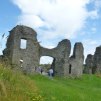 |
| Newcastle Emlyn Castle, Newcastle Emlyn, Dyfed Owned by: Scheduled Ancient Monument Thought to have been founded around 1215, this is a very early example of a Welsh castle built using stone. Between 1287 and 1289, the castle changed hands three times during the Welsh revolt by Rhys ap Maredudd against English rule. After Rhys had been defeated and killed, Newcastle became crown property and its defences were extended and improved, including the addition of the impressive gatehouse. A planned new town, or borough, was also established outside the castle walls. The castle was taken by Owain Glyn Dŵr in 1403, left in ruins it was converted into a mansion around 1500. After surrendering to Parliamentarian forces during the English Civil War, the castle was blown up to make it indefensible, it quickly fell into disuse after this. Free and open access at any reasonable time. |
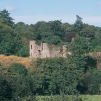 |
| Newport (Pembrokeshire) Castle, Newport, Dyfed Owned by: Scheduled Ancient Monument The Norman castle and surrounding settlement was built around 1191, by William fitz Martin. Fitz Martin had been ejected from the family home of Nevern Castle by his father-in-law, the Lord Rhys, and founded Newport to serve as the administrative centre for the district of Cemais. Captured and destroyed on at least two separate occasions by the Welsh, first by Llywelyn the Great, and later by Llywelyn the Last, the remains of the present castle date mostly from after this destruction. The castle was partially restored and turned into a residence in 1859, now under private ownership; viewing is from the surrounding area only. |
|
| Newport Castle, Newport, Gwent Owned by: Cadw The present castle dates from the early 14th century, although the buildings belong to the later 14th and 15th centuries. Evidence of an earlier Norman fortification built by Gilbert de Clare, was destroyed in order to make way for Isambard Kingdom Brunel's Great Western Railway in the 1840’s. The new castle was built by de Clare's brother in law, Hugh d'Audele, when Newport was made the administration centre for Wentloog. Built on the banks of the River Usk, the design allowed small boats to enter the castle through the gatehouse at high tide. In ruins by the 17th century, the castle motte and the rest of the bailey have been built over. Currently closed for health and safety reasons |
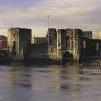 |
| Ogmore Castle, Bridgend, Glamorgan Owned by: Cadw Built by William de Londres to guard a strategic crossing of the River Ewenny, the initial Norman earth and timber ringwork castle was quickly rebuilt in stone sometime after 1116. Adding to and refortifying over the intervening years, the Londres family held Ogmore until 1298, when through marriage it became part of the Duchy of Lancaster. Damaged in the Owain Glyn Dŵr rebellion of 1405, the castle gradually fell out of use during the 16th century. Free and open access during restricted dates and times. |
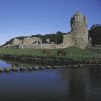 |
| Old Beaupre Castle Owned by: Cadw Perhaps more of a medieval fortified manor house than a castle, parts of Beaupre date from around 1300. Extensively remodelled during the Tudor period, first by Sir Rice Mansel, and later by members of the Basset family. The Basset family crest can still be seen on panels within the porch. Beaupre fell out of use early in the 18th century, when the then owners, the Jones family moved to New Beaupre. Restricted opening times and entrance charges apply. |
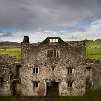 |
| Oxwich Castle, Oxwich, Glamorgan Owned by: Cadw More of a grand Tudor manor house than a castle, Oxwich was built by Sir Rice Mansel in the early 1500’s to provide elegant family accommodation. One of the more influential families in Glamorgan, Sir Edward Mansel added considerably to his father’s work by creating an even grander range containing an impressive hall and elegant long gallery. When the family moved out in the 1630’s the mansion fell into disrepair. Restricted opening times and entrance charges apply. |
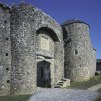 |
| Oystermouth Castle, The Mumbles, Glamorgan Owned by: Cityof Swansea council Founded by the Norman noble William de Londres around 1106, the first castle on the site was a simple earth and timber ringwork fortification. William had built several similar castles around the Gower in an attempt to secure control of the region for Henry Beaumont, Earl of Warwick. Unsubdued, the castle was sacked by the Welsh in 1116 and William was forced to flee. Rebuilt again in stone soon afterwards, the castle changed hands several times between 1137 and 1287, and by 1331 the Lords of Gower were living elsewhere. The castle gradually declined in importance and after the Middle Ages fell into ruin. Restricted opening times and entrance charges apply. |
 |
| Pembroke Castle, Pembroke, Dyfed Owned by: Philipps family Set on a rocky promontory guarding the Cleddau Estuary, the first Norman castle on the site was an earth and timber motte and bailey type fortification. Built by Roger of Montgomery during the Norman invasion of Wales in 1093, the castle withstood several Welsh attacks and sieges in the decades that followed. In 1189, Pembroke was acquired by the most famous knight of the times, William Marshal. The Earl Marshal immediately set about rebuilding the earth and timber fort into the grand medieval stone fortress that we see today. Restricted opening times and entrance charges apply. |
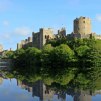 |
| Penmark Castle, Penmark, Glamorgan Owned by: Scheduled Ancient Monument High above a deep ravine of the River Waycock, Gilbert de Umfraville constructed the first earth and timber motte and bailey fortification on the site in the 12th century. Later rebuilt in stone, the castle passed to Oliver de St John when he married the young heiress Elizabeth Umfraville, in the early 14th century. Free and open access at any reasonable time. |
|
| Pennard Castle, Parkmill, Glamorgan Owned by: Scheduled Ancient Monument Originally built as a Norman ringwork type fortification with timber palisades on top of an earth mound, the castle was founded by Henry de Beaumont, earl of Warwick, after he was granted the Lordship of Gower in 1107. Subsequently rebuilt in local stone during the late 13thcentury, including a curtain wall surrounding a central courtyard with square tower. Commanding views over Three Cliffs Bay, the blowing sands from below led to the abandonment of the castle around 1400. Free and open access at any reasonable time. |
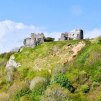 |
| Penrice Castle, Penrice, Glamorgan Owned by: Scheduled Ancient Monument Built by the de Penrice family who were gifted the land on which the castle stands for their part in the in the 13th century Norman Conquest of Gower. When the last de Penrice heiress married in 1410, the castle and its lands passed to the Mansel family. The castle’s stone curtain wall and central keep were damaged in the English Civil War of the 17th century, and landscaped into the gardens of the nearby mansion house during the 18th century. Located on private land, can be viewed from adjacent footpath. |
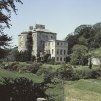 |
| Picton Castle, Pembrokeshire, Dyfed Owned by: Picton Castle Trust The original Norman motte castle was rebuilt in stone by Sir John Wogan during the 13th century. Attacked and then occupied by French troops supporting the Owain Glyn Dŵr rebellion of 1405, the castle was seized again during the English Civil War in 1645 by Parliamentary forces. Restricted opening times and entrance charges apply. |
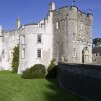 |
| Powis Castle, Welshpool, Powys Owned by: National Trust Originally the fortress of a dynasty of Welsh princes, it is thought that the first wooden structure was rebuilt in stone by Llewelyn ap Gruffudd, sometime after he had besieged and destroyed the castle in 1274. Remodelled and embellished over the centuries, the medieval fortress was gradually transformed into the grand country mansion it is today. Restricted opening times and entrance charges apply. |
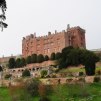 |
| Prestatyn Castle, Prestatyn, , Clwyd Owned by: Scheduled Ancient Monument Built around 1157 by Robert de Banastre, this early Norman earth and timber motte and bailey type fortification was strengthened at some point with the addition of a stone wall surrounding the bailey. Destroyed by Owain Gwynedd in 1167, the castle does not appear to have been rebuilt. Free and open access at any reasonable time. |
|
| Raglan Castle, Raglan, Gwent Owned by: Cadw Started in the 1430’s, already some 150 years late for castle building, Raglan appears to have been built for show rather than defence. Successive generations of the Herbert and Somerset families competed to create a luxurious fortified castle, complete with grand keep and towers, all surrounded by landscaped parkland, gardens and terraces. Besieged by Oliver Cromwell’s forces for thirteen weeks during the latter stages of the English Civil War, the castle eventually surrendered and was slighted, or damaged, to prevent its reuse. After the restoration of Charles II, the Somerset’s decided not to restore the castle. Restricted opening times and entrance charges apply. |
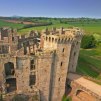 |
| Rhuddlan Castle, Rhuddlan, Clwyd Owned by: Cadw Built by the English King Edward I in 1277 following the First Welsh War, under the supervision of the king’s favourite architect master mason James of St George, Rhuddlan was not completed until 1282. To ensure that the castle could always be reached in times of trouble, Edward had the River Clwyd diverted and dredged for over 2 miles to provide a deep-water channel for shipping. Just two years later, following the defeat of Llewellyn the Last, the Statute of Rhuddlan was signed at the castle which formalised English rule over Wales. Attacked during the Welsh rising of Madog ap Llywelyn in 1294, and again by the forces of Owain Glyn Dŵr in 1400, the castle held out on both occasions. During the English Civil War, Rhuddlan was captured by Parliamentary forces following a siege in 1646; parts of the castle were blown up to prevent its reuse. Restricted opening times and entrance charges apply. |
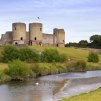 |
| Skenfrith Castle, Skenfrith, Gwent Owned by: National Trust Set on the banks of the River Monnow, the first timber and earth defences were built shortly after the Norman Conquest of England in 1066. Built to provide border defences against Welsh attack, the early castle was replaced by a more substantial stone fortress in the early 13th century. Although Skenfrith briefly saw action during the rebellion of Owain Glyn Dŵr in 1404, by 1538 the castle had been abandoned and gradually fell into ruin. Free and open access at any reasonable time. |
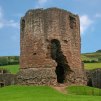 |
| St Clears Castle, St Clears, Dyfed Owned by: Scheduled Ancient Monument Set between the banks of Tâf and Cynin rivers, this Norman earth and timber motte and bailey castle was erected in the 12th century. Just below the castle, a small port on the River Tâf kept St Clears Castle and borough, or new town, supplied with the essentials of medieval life. The castle resisted capture during the Owain Glyn Dŵr rebellion of 1404. Free and open access at any reasonable time. |
|
| St Donat's Castle, Llantwit Major, Glamorgan Owned by: UWC Atlantic College Dating mainly from the 13th century, with substantial additions from the 15th and 16th centuries, St Donat's Castle has remained in almost continuous occupation since it was built. Over the centuries successive generations of the Stradling family gradually transformed the building from a military fortress into a comfortable country house. The castle is now home to UWC Atlantic College, an international Sixth Form College, and within the castle grounds lies St Donat's Arts Centre. Visitor access is usually limited to summer weekends. |
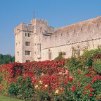 |
| Swansea Castle, Swansea, Glamorgan Owned by: Cadw The first Norman earth and timber fortification was built around 1106, on land granted to Henry de Beaumont, Lord of Gower, by the English King Henry I. Almost as soon as it was built, the castle was attacked by the Welsh. After several unsuccessful attempts the castle finally fell to Welsh forces in 1217. Restored to Henry III of England in 1220, the castle was rebuilt in stone between 1221 and 1284. The castle ceased to have a major military role after Edward I's pacification of Wales and the castle buildings were sold off, pulled down or put to alternative use. Free and open access for external viewing during restricted dates and times. |
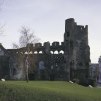 |
| Tenby Castle, Tenby, Pembrokeshire Owned by: Scheduled Ancient Monument Built by the Normans during their invasion of West Wales in the 12th century, the castle included a stone tower surrounded by a curtain wall. Captured and destroyed by Maredudd ap Gruffydd and Rhys ap Gruffydd in 1153, the castle was besieged again by the Welsh in 1187. In the late 13th century, the castle and the town came into the possession of the French knight William de Valence, who ordered the construction of the town’s defensive stone walls. Along with many other castles in the area, Tenby ceased to have a major military role following King Edward I's pacification of Wales and is thought to have been largely abandoned as a defensive fortification. In 1648 during the English Civil War, Royalists forces held Tenby Castle for 10 weeks until they were starved into surrendering by the besieging Parliamentarians. Free and open access at any reasonable time. |
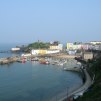 |
| Tomen y Bala, Bala, Gwynedd Owned by: Scheduled Ancient Monument Built shortly after the Norman Conquest of England, the summit of the earthen motte, or mound, would originally have been topped by a timber palisade. Possibly an administrative centre for the region, it was sacked in 1202, when Llywelyn ap Iorwerth, Prince Llywelyn the Great, drove out Elis ap Madog, Lord of Penllyn. The castle must have still have been in use in 1310, when Bala was founded as an English borough, or planned settlement, beside it. Climb the motte to view the typical grid plan of the medieval streets which still dictates the layout of the current town centre. Free and open access at any reasonable time. |
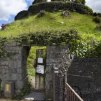 |
| Tomen-y-Mur, Trawsfynydd, Gywnedd Owned by: Scheduled Ancient Monument Built within the walls of a 1st century Roman fort, the Normans reoccupied and refortified the site by erecting a substantial earthen motte, or mound. It is possible that the motte topped by its timber palisade was constructed by William Rufus in 1095, to counter the Welsh insurgency. The name Tomen y Mur simply translates to Mound in the walls. Free and open access at any reasonable time. |
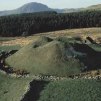 |
| Tomen-y-Rhodwydd, Ruthin, Clwyd Owned by: Scheduled Ancient Monument Erected around 1149 by the Welsh Prince Owain Gwynedd, this earth and timber motte and bailey type fortification was built to protect the borders of his princedom. The wooden castle stood until 1157, when it was burnt down by Iorwerth Goch ap Maredudd of Powys. The castle was refortified again in 1211, and used by the English King John when he invaded Gwynedd in his campaign against Llywelyn ap Iorwerth, Llywelyn the Great. Located on private land, but can be viewed from adjacent main road. |
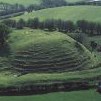 |
| Tretower Castle and Court, Tretower, Powys Owned by: Cadw The first Norman earth and timber motte and bailey type fortification on the site was erected in the early 12th century. A stone cylindrical shell keep replaced the wooden fort atop the motte around 1150, and further stone defences were added in the 13th century. In the early 14th century new residential buildings were built some distance away from the original fortifications, forming Tretower Court. The lords of Tretower apparently favoured the more luxurious surroundings of the court and the castle gradually fell into ruin. Restricted opening times and entrance charges apply. |
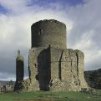 |
| Twthill Castle, Rhuddlan, Clwyd Owned by: Cadw On a spur of land overlooking the River Clwyd, this early earth and timber motte and bailey type fortification was built by Robert of Rhuddlan in 1073, to consolidate Norman advances into northern Wales. It is claimed that the site was originally occupied by the royal palace of Gruffud ap Llewelyn. Twthill changed hands several times throughout the 12th and 13th centuries, but fell into disuse in the 1280’s, when Edward I’s new Rhuddlan Castle was built a short distance away down-river. Free and open access at any reasonable time. |
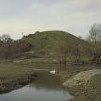 |
| Usk Castle, Usk, Gwent Owned by: Scheduled Ancient Monument Standing on a hill guarding a crossing of the River Usk, the first Norman castle was built by the de Clare family around 1138. The castle’s defences were greatly strengthened and improved by the most famous medieval knight of his day, Sir William Marshal, Earl of Pembroke, who had married Isabella, a de Clare heiress. The castle passed through numerous hands during the 14th century, including the notorious Despenser family. Following the death of Edward II in 1327, Usk was regained by Elizabeth de Burgh, who lavished money into rebuilding and remodelling the castle. Besieged during the rebellion of Owain Glyn Dŵr in 1405, the defenders, led by Richard Grey of Codnor, routed the attackers killing some 1,500 Welshmen. According to one source, 300 prisoners were later beheaded outside the castle walls. Free and open access at any reasonable time. |
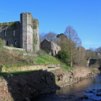 |
| Weobley Castle, Llanrhidian, Glamorgan Owned by: Cadw Perhaps more a fortified manor house than a castle, Weobley was built by the 'elegant and refined' de la Bere family in the early 14th century. Badly damaged during the rebellion of Owain Glyn Dŵr in 1405, Sir Rhys ap Thomas lavished funds to transform Woebley into the luxurious residence that would reflect his new social status as Governor of Wales. Rhys had recently been knighted on the Bosworth battlefield after slaying Richard III, in August 1485. Restricted opening times and entrance charges apply. |
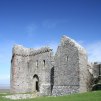 |
| White Castle, Llantilio Crossenny, Gwent Owned by: Cadw The castle derived its name from the whitewash that once adorned the stone walls; originally called Llantilio Castle it is now the best preserved of The Three Castles, namely, White, Skenfrith and Grosmont. The term The Three Castles refers to the fact that for a large part of their history they guarded a single block of territory under the control of Lord Hubert de Burgh. The Monnow Valley was an important route between Hereford and south Wales in medieval times. Unlike its neighbours, White Castle was not built with residential accommodation in mind, suggesting that it served only as defensive fortress. Along with many other castles in the area, White Castle ceased to have a major military role following King Edward I's pacification of Wales and is thought to have been largely abandoned after the 14th century. Restricted opening times and entrance charges apply. |
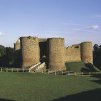 |
| Wiston Castle, Haverfordwest, Pembrokeshire Cadw Built around 1100, this typical Norman motte and bailey fortification was actually built by a Flemish knight called Wizo, from whom the castle takes its name. Captured twice by the Welsh during the 12th century, it was quickly recaptured on both occasions. Demolished by Llywelyn the Great in 1220, Wiston was later restored by William Marshal but was finally abandoned when Picton Castle was built at the end of the 13th century. Free and open access during restricted dates and times. |
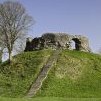 |
Have we missed something?
Although we've tried our hardest to list every castle in Wales, we're almost positive that a few have slipped through our net... that's where you come in!
If you've noticed a site that we've missed, please help us out by filling in the form below. If you include your name we'll be sure to credit you on the website.
